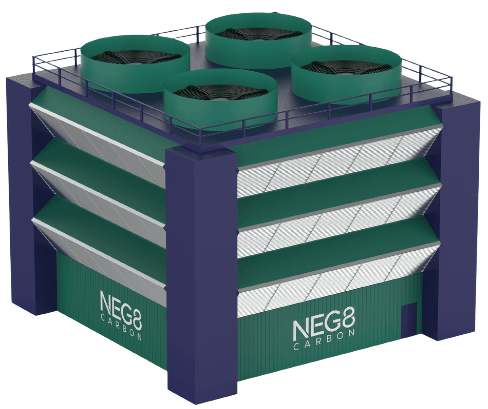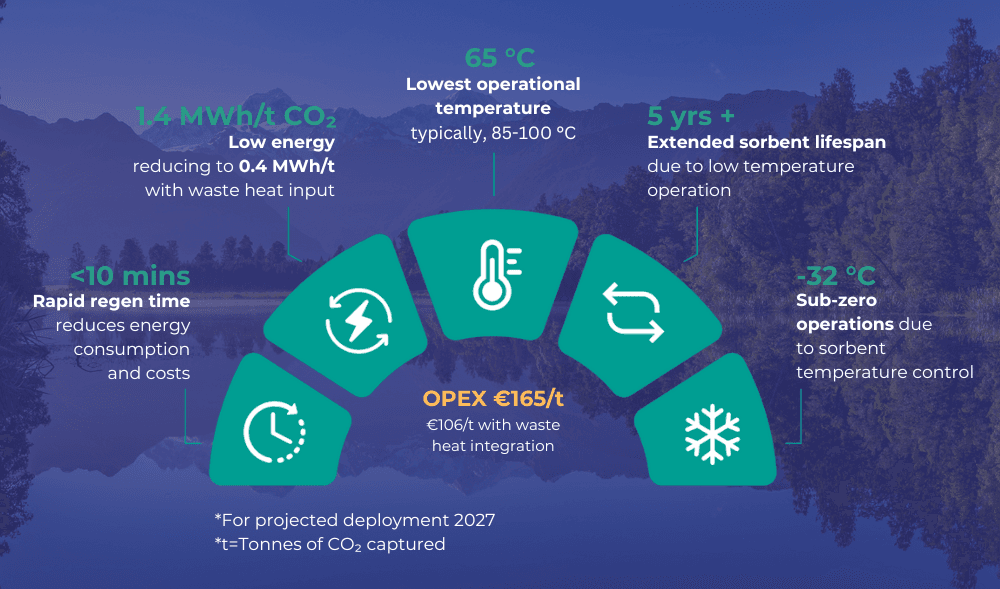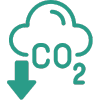
How NEG8 Carbon's Electrostatic DAC Technology Works
Direct Air Capture is a technology that removes carbon dioxide (CO₂) from the air. In the NEG8 Carbon solution, atmospheric air is drawn into the unit by large fans and is passed over a specifically designed sorbent that attracts and captures CO₂ molecules.
We use our patent pending Electrostatic DAC technology to create stable, thin, active layers of sorbents on highly sensitive surfaces.
When the sorbent is heated, the concentrated CO₂ is released. The captured CO₂ can then be permanently and safely stored underground or used in climate-neutral carbon products, such as Sustainable Aviation Fuel (SAF) and sustainable concrete.
(Learn more: How Does Direct Air Capture Work?)
Our DAC technology is based on modular, scalable ‘plug-and-play’ units designed for large-scale distributed operation. The technology was proven by a prototype in 2022 that captured 1.2 tonnes of CO₂ annually, while the DAC towers currently being developed will capture 5000 – 6000 tonnes of CO₂ per annum each.
Unique Advantages of NEG8 Carbon's DAC Technology

Carbon Capture Innovations
NEG8 Carbon is continuously pursuing technological advancement to bring down energy, process and manufacturing costs to make DAC widely accessible.
Advanced Sorbent Deployment
NEG8 Carbon has developed a novel way of deploying sorbents, the material used for capturing the CO₂.
It uses a revolutionary method for fixing and releasing the sorbent in a thin layer to a heat exchanger.
Benefits:
- Faster CO₂ capture and release
- Low volume of sorbent
- Ease of loading/ unloading sorbent to/ from the heat exchanger
Enhanced Heat
Exchange Process
This technology dramatically improves the heat exchange process within the DAC system. It optimises heat transfer to the sorbent material, enabling faster heat transfer, improving the efficiency of the sorbent’s regeneration process and increasing the rate of CO₂ capture.
Benefits:
- Rapid regeneration time (10 minutes)
- Low regeneration temperature
- Dramatic increase in CO₂ capture rate
- Highly energy efficient
Carbon Capture Challenges and Solutions

Energy Efficiency and Sustainability
The NEG Carbon DAC system requires less energy than conventional DAC solutions, making it more cost-effective and environmentally friendly. Our latest innovations reduce power usage by using less sorbent and lowering the temperature needed for CO₂ extraction to 65°C. This not only saves energy but also extends the lifespan of the sorbent.
The energy consumption of NEG8 Carbon’s DAC units is 0.4 MWh/t CO₂ with low grade waste heat and 1.4 MWh/t CO₂ without waste heat input.
A useful byproduct of our DAC system is pure water which further enhances operational sustainability.

Sequestration and Utilization
To reduce or eliminate transport emissions, cost and risks, DAC parks can be located at the site of sequestration and/or utilization, away from urban areas. Alternatively, the captured CO₂ can be stored safely in depleted oil wells or other certified storage areas.
Moreover, DAC sites can be powered by off-grid renewable energy which means they do not interfere with the local community’s power supplies.
Learn more about:
Carbon sequestration
Carbon utilization

Deployment and Maintenance Costs
We have a relentless focus on driving down the Capital and Maintenance costs of our DAC systems.
We aim to use ready-made components to bring down Capital costs. And by developing technologies to use less sorbent that has a longer life, we are lowering Operational costs and extending the lifespan of the system.
Additionally, our modular design makes the system easier and cheaper to scale for larger projects.

Monitoring, Reporting, and Verification (MRV)
A key feature of DAC technology is its ability to measure CO₂ capture accurately, which promotes transparency and credibility for carbon emission compliance.
With innovations that lower power costs and increase sorbent efficiency, we are aiming to drive down DAC capture costs to around €165 per tonne of CO₂ captured by 2027, €100 per tonne by 2035 and €80 per tonne by 2050.
NEG8 Carbon DAC Technology in Action
People Often Ask
What is Direct Air Capture?
Direct Air Capture is a technology that uses molecular technology to extract carbon dioxide (CO₂) from the air to fight climate change caused by CO₂ emissions.
More About Direct Air Capture
How Does Direct Air Capture Work?
Direct Air Capture technology works by drawing in large quantities of air and passing it over specifically designed nano materials that attract and capture carbon dioxide molecules.
More About How Direct Air Capture Works
What Happens to the Captured CO₂?
The captured CO₂ can be permanently and safely stored underground using geological mineralisation or in depleted oil and gas wells. Another option is to use the CO₂ in making climate-neutral carbon products, such as sustainable aviation fuel (SAF), contributing to a cleaner, greener future.
More About Carbon Sequestration and Carbon Utilization
Difference Between Direct Air Capture & Point Source Carbon Capture
Direct Air Capture removes the already emitted CO₂ in the atmosphere at any location in the world, while point source carbon capture takes place at the point of emission, such as a power station. There are distinct differences in their roles and benefits. Find out more:
More About Direct Air Capture vs Point Source
